

Our main postcard is in the Valentines series and dates from around 1904. It shows a car of the Douglas Southern Electric Tramways Ltd. on the Wallberry Viaduct. The smaller view below is from around the same date and is the viaduct from the other direction, with Horse Leap viaduct beyond. This postcard was produced by S. Hildesheimer & Co. Ltd. of London and Manchester and was one of a small series of scenic cards sold by the Douglas Southern. Further such cards are shown at the end of this page.
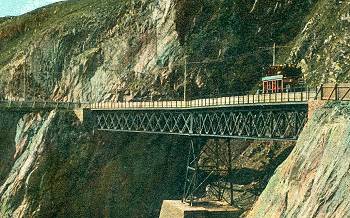 The Douglas Southern, owned by the General Traction Co. (after 1896 New General Traction Co.) was the only tramway on the Isle of Man to be built to the British standard gauge of 4ft 8½in, most other tramways and railways being to 3ft gauge. The Douglas Head Marine Drive was constructed in the early 1890s to provide a toll road giving access to the highly scenic cliffs to the south of the town of Douglas. By late 1893 the three-mile long section as far as Keristal was complete. From the outset it was envisaged that an electric tramway would serve along the new road. The first two-mile section to the Whing opened for service on 7th August 1896. The following season the Marine Drive was completed and the tramway opened on 1st April 1898 to its final destination of Port Soderick, a total length of 3¼ miles of single track with originally eleven passing loops. Operation was always seasonal, closing over the winter period. Power was generated at the company's own generating station at Pigeon's Stream, near Douglas Head and the depot was at Little Ness. At the ends of the line, the tramway was served by two funiculars, the Port Soderick Holiday Beach Lift and the Douglas Head Incline Railway. The most notable features were of course its impressive viaducts and the gate at the Douglas end of the Marine Drive.
The Douglas Southern, owned by the General Traction Co. (after 1896 New General Traction Co.) was the only tramway on the Isle of Man to be built to the British standard gauge of 4ft 8½in, most other tramways and railways being to 3ft gauge. The Douglas Head Marine Drive was constructed in the early 1890s to provide a toll road giving access to the highly scenic cliffs to the south of the town of Douglas. By late 1893 the three-mile long section as far as Keristal was complete. From the outset it was envisaged that an electric tramway would serve along the new road. The first two-mile section to the Whing opened for service on 7th August 1896. The following season the Marine Drive was completed and the tramway opened on 1st April 1898 to its final destination of Port Soderick, a total length of 3¼ miles of single track with originally eleven passing loops. Operation was always seasonal, closing over the winter period. Power was generated at the company's own generating station at Pigeon's Stream, near Douglas Head and the depot was at Little Ness. At the ends of the line, the tramway was served by two funiculars, the Port Soderick Holiday Beach Lift and the Douglas Head Incline Railway. The most notable features were of course its impressive viaducts and the gate at the Douglas end of the Marine Drive.
The rolling stock consisted of twelve open-sided, double-deck cars which seated 75, 39 on the upper deck and 36 on the lower. They were built for the opening of the line by the Brush Electrical Engineering Co. Ltd of Loughborough. They were mounted on 6ft 6in wheelbase "Lord Baltimore" 4-wheel trucks from the Baltimore Car Wheel Co. of Baltimore, Maryland, USA. Cars 1-6 were each fitted with two Westinghouse 12A 25hp motors and had Westinghouse type 28A controllers. Cars 7-12 had identical trucks but without motors and were used as trailers. It was considered that at some time in the future they could be motorised and indeed this did happen to cars 7 and 8 in 1897 when Brush delivered four new trailers 13-16 to the same design but on horse car style trunnion running equipment and with one extra seat on the upper deck in the space where the trolley pole could have been fitted on the earlier batch. Cars 7 and 8 were fitted with General Electric 800B 27hp motors and GE K2 controllers. The livery was crimson and white. Views of the rolling stock can be seen in our Historical Photos section.
Operation of the line was fairly uneventful. There was a minor accident in 1909 damaging car 3 and to maintain service while repairs were made, car 3 swapped equipment and identity with trailer car 11. The tramway closed for the duration of the First World War, reopening in summer 1919. The original operating franchise ended in 1926 and the tramway was sold by the New General Traction Co. to the Marine Drive company. Tourist traffic had by then started to fall off. After the outbreak of the Second World War, the line completed the season on 15th September 1939 but never ran again. At various times after the war, Douglas Corporation operated bus services on parts of the Marine Drive, but today most of it is a footpath.
One tram survived, car 1. Rescued from the closed depot in 1951, it was stored locally for a while at the Quarter Bridge yard of the IoM Highway and Transport Board, but in 1955 passed to the British Transport Commission. After a repaint at London Transport's Charlton (former tram) Works, under the supervision of the late Richard Elliott (a founder member and former President of the Tramway & Light Railway Society), it was put on display in the Museum of British Transport at Clapham. On that museum's closure in 1973 it became part of the Science Museum reserve collection and since 1975 has been loaned to the National Tramway Museum for normally static display at Crich, where it can be seen today.
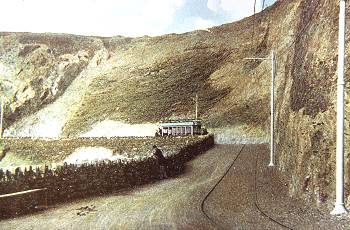
The tramway at the Whing |
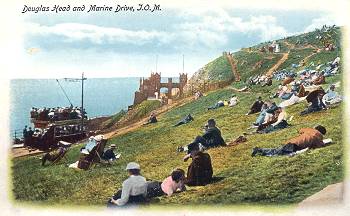
Douglas tram terminus |
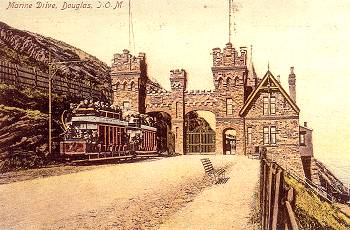
The Marine Drive toll gates, south side |
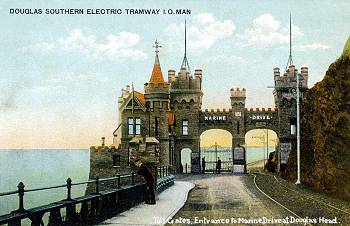
The Marine Drive toll gates, north side |
![]() Go to Postcard Of The Month Index
Go to Postcard Of The Month Index